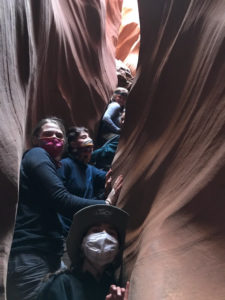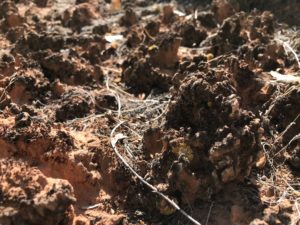 A flash of blonde hair disappears in front of me as Lauren squeezes her body into the hole. I step forward–it’s my turn. I squat down low, and slip my feet through the narrow slit, just big enough to get my shoulders through. My feet make contact with the wall; I take a breath and trust my instinct.
A flash of blonde hair disappears in front of me as Lauren squeezes her body into the hole. I step forward–it’s my turn. I squat down low, and slip my feet through the narrow slit, just big enough to get my shoulders through. My feet make contact with the wall; I take a breath and trust my instinct.
As I lower my body down, my shoulders glide effortlessly through the crack. My eyes focus to the darkness, noticing the group slowly moving ahead. I apply equal pressure to my hands and feet against opposite walls, merely two feet apart. In this position, I can slowly stem my body forward with delicate movement, careful to avoid the water puddle below. The canyon begins to open up affording us enough room to walk on the ground. Meandering through the depths of the canyon, I hear a shout of exclamation as Emet stumbles upon an owl feather. It has an intricate pattern with frayed edges. It must have belonged to someone native to this area–an owl who knows the ins and outs of this foreign landscape.
As I look up, trying to imagine an owl perching on the walls above, I notice the pattern of the Navajo layer of sandstone, displaying varying shades of tan, orange, brown and red. Each line in the sandstone represents a distinct moment in time.
We make our way deeper into the canyon, and I begin to question who came before us? Which Indigenous groups created the petroglyphs on the walls above the canyon? How long were they here? What scars will the earth carry from the impacts of our society today?
The scars we have encountered on our trip thus far are abundantly visible in the cryptobiotic soil. Crypto, as our WRFI group refers to it, is a living crust that makes up the topsoil of the desert. The crust looks like a dark, bumpy surface, with small peaks that can grow up to a few inches in undisturbed areas. The colors of the crust range from red to brown, and almost black-looking in highly developed locations. To the untrained eye, this may look insignificant, but to a seasoned adventurer, one knows that this is the heart of the desert ecosystem, pumping nutrients to areas desperately in need. 
One of the Bureau of Land Management’s Assistant Field Managers, Sue Fivecoat, talked with our group about the lasting impacts in the front-country from improper and reckless individuals during the COVID-era. RV sales saw an increase of 900% during the last year as people became eager to escape the house during quarantine. Due to excessive off-road driving and inappropriate camping in non-designated areas, the cryptobiotic soils have been dramatically affected.
In A Naturalist’s Guide to Canyon Country, Williams notes how a small area can take anywhere from 15-250 years to recover, and even longer for a larger area. This extremely fragile crust is vital to desert ecosystems, but unfortunately easily disturbed by footprints, tire marks, dog tracks and almost anything in between. Cryptobiotic soil is critical in desert shrub and grassland communities because it fixes carbon and nitrogen in the ground. Livestock Grazing and Wildlife Conservation, by Tomas Fleishner, discusses how these sources of nutrients help to keep the “interspaces between vascular plants fertile and support other microbial populations.” Moreover, the crypto functions as a plant nursery for the desert, fostering growth and protection for seeds. This ultimately acts as the glue holding everything together.
With this in mind, I equally ponder if we could use our existence on this earth to do and be something entirely different? To create a society that works in harmony with Earth’s resources, and to foster love and engagement with our surroundings? Can we change our relationship with the land, diverting our resources from monoculture in order to promote sustainable farming practices and heal the wounds we have inflicted upon our soil?
I don’t know the answers to these questions, but I do know that I am continually perplexed by the beauty of our world. I want to be a force for change, fostering love and appreciation for this Earth we get to call home. In turn, I challenge you to ask yourself, what is the mark you want to leave on this Earth? I’m not sure how the mark of my generation will be reflected on these canyon walls, and on this living desert soil, but I certainly hope my curiosity and awe will inspire those around me to generate a respectful relationship with our environment.
As water starts to seep over the edge of my boot, I am brought back to this moment. Water sloshes around the edge of the puddle as I round the next corner. The sandstone is cold, damp and gritty–it is a nice break from the sun beating down just above the walls of the slot canyon. The light illuminates the walls around me as I emerge from the depths within. I am left with a sense of gratitude, as well as a small puddle in my boots.
6 Replies to “The Marks We Make by Alexandra Bierman”
Comments are closed.
What a beautiful description of your journey and insight! It sounds like a marvelous experience! Blessings!
Ali, what a clear, insightful piece of writing. It appears you are exactly where you are meant to be, soaking up the earth’s energy and making your own positive, indelible mark. You are an inspired and natural protector, and you make change possible. Enjoy every moment. Love you lots.
Keep the pondering coming! I’m so proud of your big picture thinking and your intimate connection to nature. Stay present in every moment. I’m so jealous.
Ali I’m so proud of you..your experiencing an amazing trip .love reading your posts
love u Granny
Beautifully written, Alexandra. Emet shouting excitedly about a feather. That’s my daughter alright.
You’re relentless pursuit of understanding all that is around you comes through.